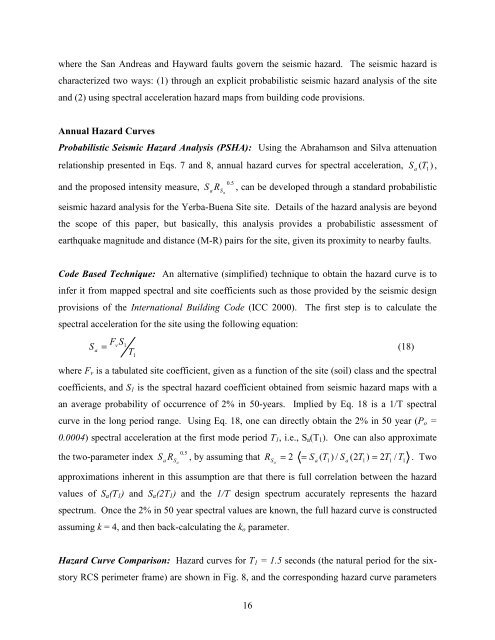DRAFT: US-JAPAN PBEE PAPER BY CORDOVA ... - PEER
DRAFT: US-JAPAN PBEE PAPER BY CORDOVA ... - PEER
DRAFT: US-JAPAN PBEE PAPER BY CORDOVA ... - PEER
Create successful ePaper yourself
Turn your PDF publications into a flip-book with our unique Google optimized e-Paper software.
where the San Andreas and Hayward faults govern the seismic hazard. The seismic hazard ischaracterized two ways: (1) through an explicit probabilistic seismic hazard analysis of the siteand (2) using spectral acceleration hazard maps from building code provisions.Annual Hazard CurvesProbabilistic Seismic Hazard Analysis (PSHA): Using the Abrahamson and Silva attenuationrelationship presented in Eqs. 7 and 8, annual hazard curves for spectral acceleration, S aT ) ,and the proposed intensity measure,SaR Sa0.5( 1, can be developed through a standard probabilisticseismic hazard analysis for the Yerba-Buena Site site. Details of the hazard analysis are beyondthe scope of this paper, but basically, this analysis provides a probabilistic assessment ofearthquake magnitude and distance (M-R) pairs for the site, given its proximity to nearby faults.Code Based Technique: An alternative (simplified) technique to obtain the hazard curve is toinfer it from mapped spectral and site coefficients such as those provided by the seismic designprovisions of the International Building Code (ICC 2000). The first step is to calculate thespectral acceleration for the site using the following equation:F SSv 1a= (18)T1where F v is a tabulated site coefficient, given as a function of the site (soil) class and the spectralcoefficients, and S 1 is the spectral hazard coefficient obtained from seismic hazard maps with aan average probability of occurrence of 2% in 50-years. Implied by Eq. 18 is a 1/T spectralcurve in the long period range. Using Eq. 18, one can directly obtain the 2% in 50 year (P o =0.0004) spectral acceleration at the first mode period T 1 , i.e., S a (T 1 ). One can also approximatethe two-parameter index0.5SaR Sa, by assuming that RS a2 = Sa( T1 ) / Sa(2T1) = 2T1/ T1= . Twoapproximations inherent in this assumption are that there is full correlation between the hazardvalues of S a (T 1 ) and S a (2T 1 ) and the 1/T design spectrum accurately represents the hazardspectrum. Once the 2% in 50 year spectral values are known, the full hazard curve is constructedassuming k = 4, and then back-calculating the k o parameter.Hazard Curve Comparison: Hazard curves for T 1 = 1.5 seconds (the natural period for the sixstoryRCS perimeter frame) are shown in Fig. 8, and the corresponding hazard curve parameters16
















